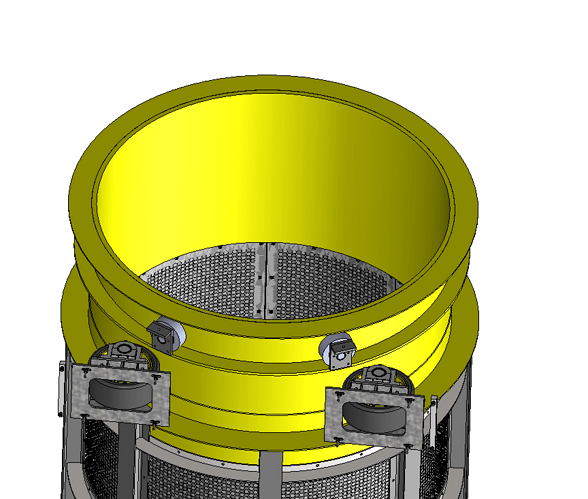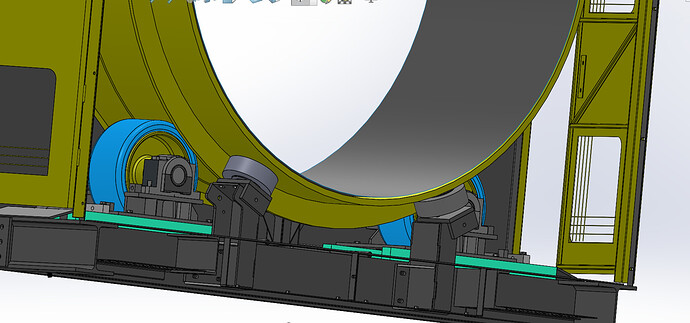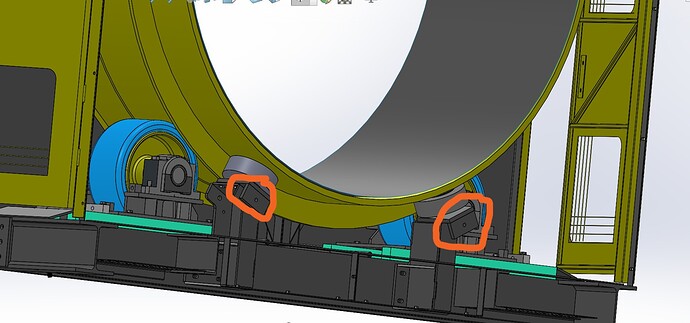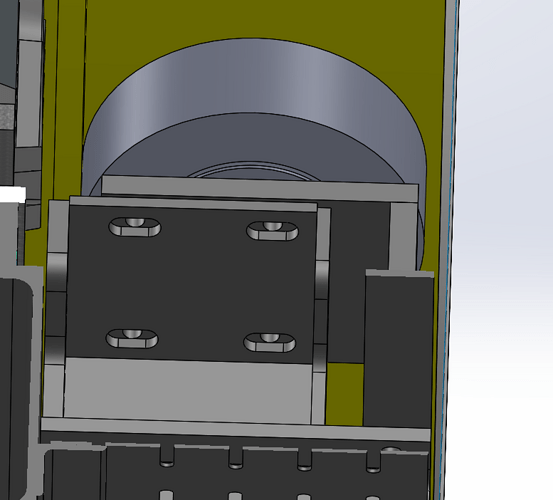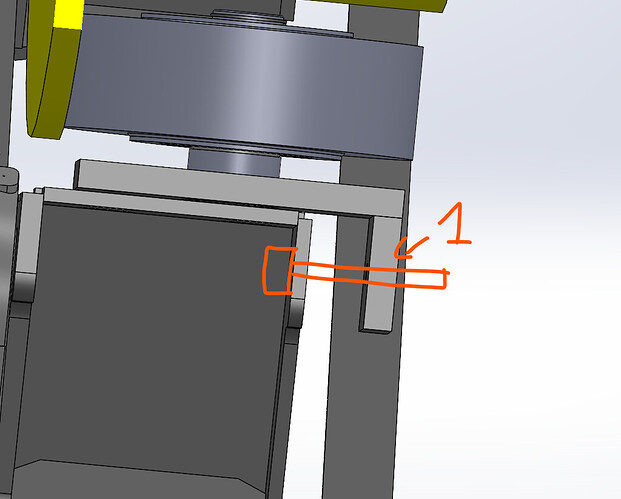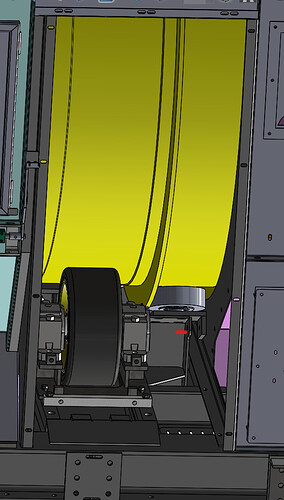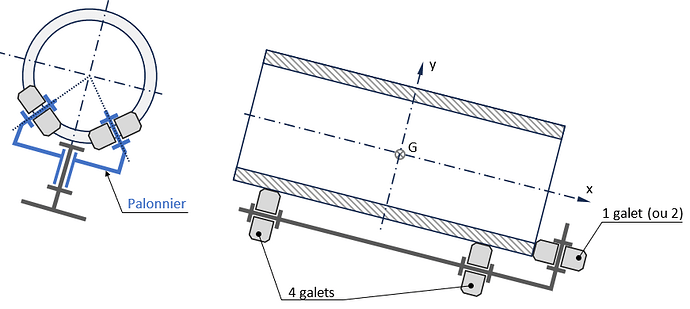Bonjour j’ai besoin de votre aide.
j’ai un tube de 16 tonnes pour un Ø2500mm incliné à3° avec une rotation de 50t/min.
je dois placer un galet de retenu en bout du tube pour bloquer sa translation du à son mouvement et le force de gravité
j’ai 2 questions.
1= quelle est la force en bout de tube pour un galet au centre.
2= quelle est la force en bout de tube pour 2 galets espacé de 50°.
merci pour votre aide
Comment est-il entraîné en rotation ? Galets motorisés type vireur ?
le tube est posé sur 4 roues dont une motorisé.
Bonjour;
Le poids (P) : P = m * g = 16000 kg * 9.81 m/s² = 156960 N
La composante du poids parallèle au plan incliné : F = P * sin(3°) = 156960 N * 0.0523 = 8209 N
Donc pour un seule galet placé au centre du tube sa force de retenue est égale à la composante du poids parallèle au plan incliné :
Force pour un Galet = = 8209 N
Pour deux galets espacés de 50°, la force se répartira entre les deux points de contact. Nous pouvons utiliser la formule de la résultante des forces pour calculer la force sur chaque galet :
F_retenue_2 = F / (2 * cos(25°))
F_retenue_2 = 8209 / (2 * 0.9063) = 4528 N par galet
La force totale de retenue sera donc de 4528 N * 2 = 9056 N, légèrement supérieure à la configuration avec un seul galet en raison de la répartition des forces.
=> J’ajouterai la nécessité d’ajouter un coefficient de sécurité sur ces galets pour compenser les forces centrifuges générées par la rotation du tube…
Sans connaitres les matériaux en jeux il n’est pas évident de calculer les efforts de frottements.
merci beaucoup.
voila la ref de galet utilisé
galet polyamide GSPO 252/50K Charge 6000 daN
BLICKLE est un bon fournisseur, produits de qualité.
Pas de commentaire sur le modèle choisi.
Par contre si je puis me permettre j’aurais inversé le côté de la butée de réglage de la position des galets de la platine, car une fois réglés - les efforts de poussés étant tout de même non négligeables, peut-être y aura t’il également des vibrations (vitesse linéaire de 400m/mn) - il sera plus simple de positionner des cales calibrées entre le support et la platine. Gage de rigidité et de stabilité dans le temps.
merci pour ta proposition.
mais difficile de changer la position car j’ai pas de place.
le galet est fixé par dessous
le réglage se fait à l’aide d’une vise M20 sachant que en rep1 on est taraudé.
pfffff le coté obscure pointe le bout de son nez ![]()

Merci à tout les intervenants pour votre participation.
Que la force soit avec vous.
Pour déterminer la force exercée en bout du tube par la gravité et la rotation, analysons la situation sous deux configurations :
Données fournies :
Masse du tube : 16 tonnes (16’000 kg)
Diamètre : Ø2500 mm (R = 1250 mm)
Inclinaison : 3°
Vitesse de rotation : 50 tours/min (ω = 50 × 2π / 60 rad/s ≈ 5.24 rad/s)
Gravité : g = 9.81 m/s²
Cas 1 : 1 galet au centre
Cas 2 : 2 galets espacés de 50°
- Calcul de la force en bout de tube pour 1 galet au centre
Force due à la gravité (Fg)
La force de gravité génère une composante parallèle au plan incliné qui tend à faire glisser le tube :
F_g = m \cdot g \cdot \sin(3°)
Force centrifuge (Fc)
L’effet de la rotation engendre une force centrifuge sur le centre de gravité :
F_c = m \cdot R \cdot \omega^2
Toute cette force est transmise au galet unique.
- Calcul de la force pour 2 galets espacés de 50°
Lorsqu’il y a deux galets, la force est répartie entre les deux, en fonction de leur position et de la direction des forces. Chaque galet reçoit une partie de la force résultante.
Je vais effectuer les calculs pour ces forces et vous donner les résultats précis.
Résultats des calculs :
-
Force due à la gravité (Fg) : 8.21 kN
-
Force centrifuge (Fc) : 548.31 kN
-
Force totale sur un seul galet : 548.37 kN
-
Force sur chaque galet (avec 2 galets espacés de 50°) : 302.53 kN par galet
Donc :
Si vous utilisez 1 seul galet, il devra supporter environ 548.37 kN.
Si vous utilisez 2 galets espacés de 50°, chacun supportera 302.53 kN.
Bonjour;
J’ai eu un doute en lisant votre réponse, ne serait-ce que parce qu’elle ne comporte pas de « Bonjour : », alors je suis allé vérifier sur:
et aussi sur:
https://quillbot.com/ai-content-detector
… Merci de citer vos sources lorsque vous utilisez une I.A …pas qu’elles soient toutes mauvaises mais il ne faut jamais oublier qu’elles peuvent halluciner à n’importe quel moment… un peu comme les humains d’ailleurs.
Je pense que le fait de signaler l’utilisation d’une réponse d’I.A est surtout une question d’étique et de respect.
Et si jamais je me trompe, veuillez accepter toutes mes excuses.
@OBI_WAN : Je n’ai pas l’occasion de vérifier les calculs mentionnés, après tout, c’est peut-être moi qui hallucine… ![]()
Bonjour @Maclane ,
Effectivement, il faut se méfier de l’I.A.
Je dirais que ses réponses sont souvent pertinentes, mais conditionnées par la précision de la question posée, qui doit être clairement et complètement formulée.
En particulier, la réponse de @maurizio comporte une confusion, qui n’est pas due à ChatGPT : dans le cas de la « force centrifuge » (Fc = m w² r), le rayon r à prendre en compte est la distance de l’axe de rotation au centre de gravité de l’objet, et non le rayon R du cylindre. On peut penser que cette distance r est très faible si le cylindre est de qualité convenable.
Par ailleurs, « l’effort centrifuge » agit radialement, et n’a pas de projection sur la direction de l’axe du tube.
A mon avis, cette action centrifuge est parfaitement négligeable dans le choix des galets de l’appui axial.
Pour revenir au problème posé initialement - calcul de la force axiale pour valider le ou les galets - le fait d’utiliser 2 galets mérite une réflexion. Je m’explique :
Pas de problème pour le guidage en rotation du tube qui est réalisé par 4 galets (dont un est motorisé), ce qui définit l’axe de rotation.
En revanche, rien ne garantit que les galets utilisés pour l’arrêt axial seront tous les deux au contact de la face avant du tube. Tout dépend de la qualité des surfaces, usinées ou brutes, perpendicularité de la face avant par rapport aux portées cylindriques…
Même si les galets « axiaux » disposent d’un système de réglage qui assure leur appui simultané, rien ne dit qu’il en sera de même un demi-tour plus loin, ou pour un autre tube.
Une fois de plus, c’est le caractère hyperstatique du montage à deux galets qui ne permet pas d’être affirmatif quant à l’égalité des efforts qu’ils supportent. Au concepteur d’imaginer une solution pour garantir le double appui…
Bonjour @Maclane,
Je comprends votre souci quant à l’origine des réponses et l’importance de citer ses sources lorsqu’on utilise une IA. Toutefois, je tiens à préciser que ma réponse est le fruit de mon propre raisonnement et de mes connaissances techniques.
Si vous avez un doute sur mes calculs ou ma démarche, je serais ravi d’en discuter et de les justifier point par point. L’important, à mon sens, est de s’assurer que les explications sont correctes et utiles à la communauté.
N’hésitez pas à me dire quels points vous semblent problématiques, et nous pourrons les revoir ensemble.
Bonne journée !
Bonjour,
c’est très exactement ce qui se passe. un usinage est réalisé sur les faces de contacts avec une tolérance de perpendicularité avec l’axe de rotation mais vue la taille du tube il n’y a que un galet qui est en contacte permanent et le second par intermittence. on laisse tout de même le second en cas de casse du premier.
Salut @OBI_WAN
Du coup ne serait il pas judicieux de n’avoir qu’un seul galet mais placé à l’axe (ce qui permettrai un meilleur équilibre des forces par rapport au fait de n’avoir 1 seul galet en contact mais pas dans l’axe) ?
Surtout qu’avec 2 galets, si jamais le surnuméraire est monté trop proche et qu’il rentre effectivement en contact, tu va te retrouver avec de la fatigue alternée sur tes 2 galets / supports (donc risque de casse accru sur le long terme).
@froussel
oui tu as raison mais placer à l’axe le galet deviens inaccessible pour une maintenance. le choix de le placer à 50° et justement de le rendre accessible.
Bonjour @OBI_WAN ,
Une disposition avec un palonnier pour relier les deux galets est peut-être la solution :
- répartition théoriquement identique des efforts sur les deux galets (si la pivot du palonnier est « centrée »);
- accessibilité préservée, identique à celle avec deux galets à axes fixes.
Et la liaison pivot n’a pas besoin d’être particulièrement soignée, puisque l’amplitude du mouvement est insignifiante, seulement due aux défauts géométriques du tube.


